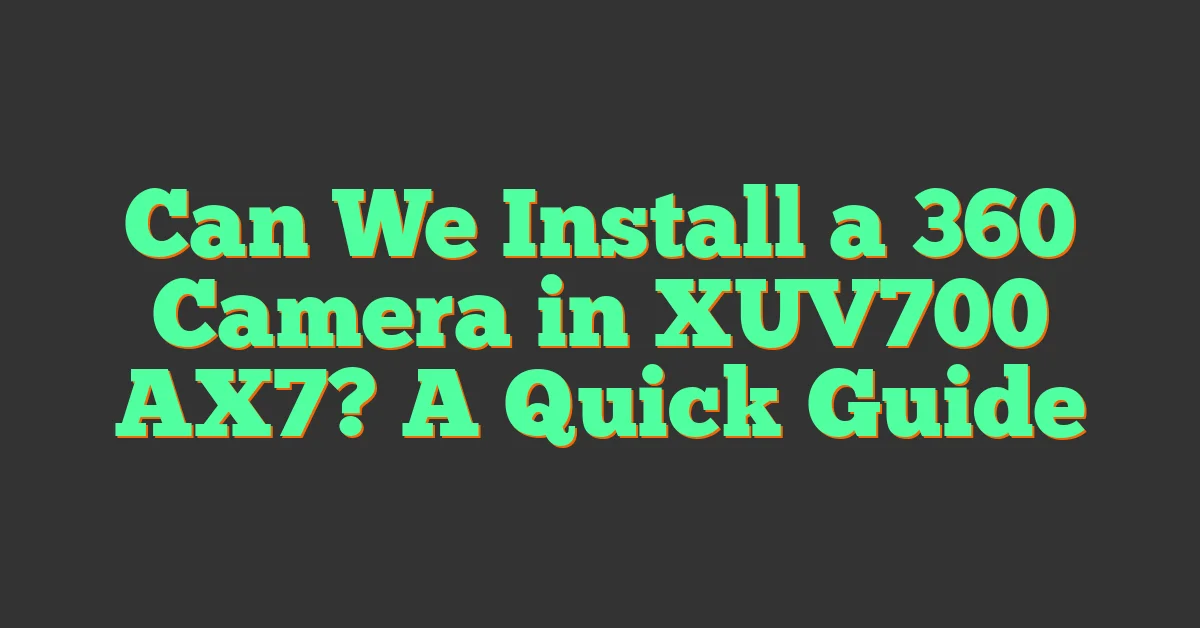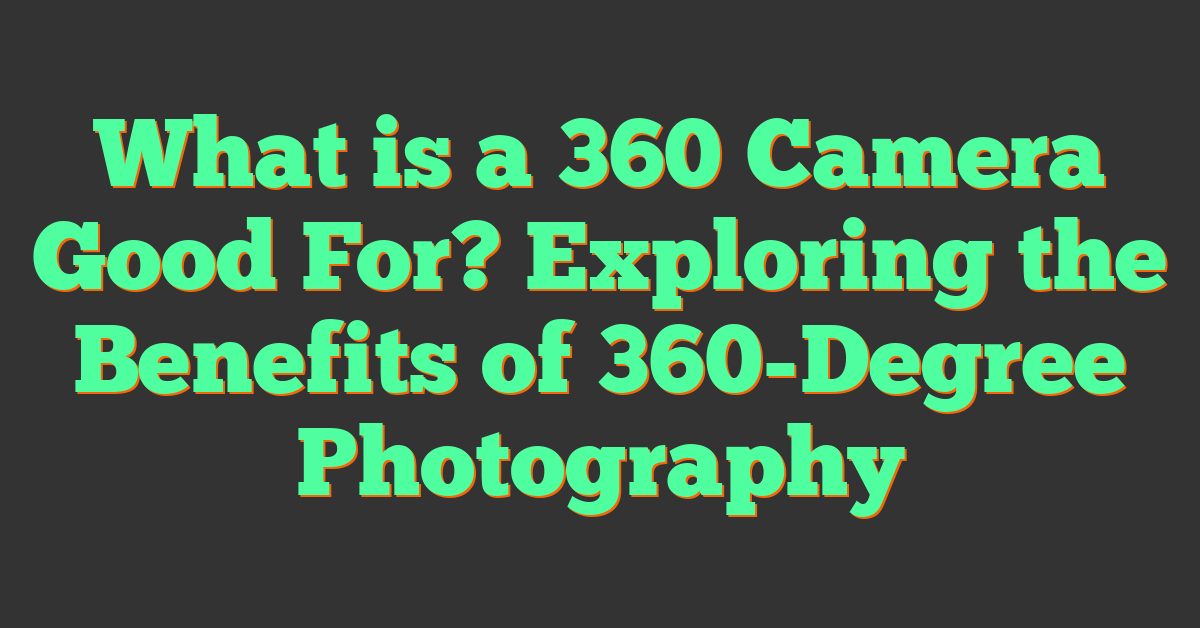Key Takeaways
- 360 cameras offer full 360° spherical imagery, making them ideal for immersive experiences like virtual tours, VR content, and action-packed scenes.
- Panoramic photos capture wide-angle static images, perfect for landscapes, cityscapes, and high-resolution prints.
- Ease of use differs significantly: 360 cameras handle automatic stitching and are ready for VR, while panoramic photos often require manual input or post-processing.
- Cost and equipment vary: 360 cameras demand a dedicated device, while panoramic photos can be created with standard cameras using existing gear or smartphone modes.
- Choose based on goals: Use a 360 camera for interactive and dynamic outputs; opt for panoramic photos for expansive, static compositions and budget-friendly options.
- Both methods have pros and cons, but understanding your creative vision and technical needs will help determine the best fit for your projects.
Capturing the world around us has never been easier, but with so many options, it’s tough to know what’s right for your needs. Two popular ways to create immersive visuals are 360 cameras and panoramic photos. While they might seem similar at first glance, they’re actually quite different in how they work and the experiences they offer.
I’ve noticed many people confuse these two technologies, but understanding the difference can help you decide which one suits your creative vision. Whether you’re aiming for interactive, fully spherical views or wide-angle shots stitched together, each has its own strengths. Let’s dive into what sets them apart.
Understanding 360 Cameras
360 cameras have revolutionized how photographers and videographers capture immersive and interactive imagery. These devices stand out for their ability to record everything around them, delivering a complete spherical view.
What Are 360 Cameras?
360 cameras are devices engineered to capture spherical imagery or video in a single shot. With dual-lens (or more) systems, they simultaneously photograph or record the surroundings, then seamlessly stitch the footage together. Unlike traditional cameras, 360 cameras cover 360° horizontally and vertically, creating content that mimics real-life perspectives.
Most 360 cameras are compact, portable, and intuitive to operate. They’re ideal for virtual tours, action shots, or VR content, making them popular in real estate, travel, and professional cinematography. For example, a typical 360 camera captures a realistic wide-angle scene without requiring external software to stitch photos.
Key Features of 360 Cameras
- Dual or Multi-Lens Setup: 360 cameras use multiple lenses to capture a full sphere. For instance, a typical model has two ultra-wide fisheye lenses.
- Automatic Stitching: Modern 360 cameras process and merge footage automatically, eliminating the need for post-production stitching software.
- High-Resolution Capture: Many 360 cameras shoot 4K or higher to ensure sharp visuals for immersive experiences.
- Compact and Portable Design: Devices like the Insta360 ONE X2 are lightweight, easy to carry, and well-suited for mobile filming.
- Compatibility with VR Systems: 360 recordings seamlessly integrate into virtual reality projects, enabling authentic 3D-like environments.
Pros and Cons of 360 Cameras
Pros
- Enhanced Immersion: Viewers experience the full environment, making them feel part of the action.
- Versatility: Perfect for capturing events, landscape photography, or adventurous moments.
- Simplicity: Automatic features like stitching and horizon leveling save time.
- Advanced Sharing Options: Platforms like YouTube and Facebook support 360 video playback.
Cons
- High File Sizes: Videos, especially in 8K or 4K, require significant storage.
- Limited Editing: Detailed edits can be tricky because of spherical formats.
- Stitch Lines: Although minimized, stitch marks can appear, especially in close-range footage.
- Price: Quality 360 cameras, such as the GoPro Max, can be expensive for beginners.
Photographers and videographers can use 360 cameras to create vivid content that traditional methods can’t replicate, ensuring a unique creative edge.
Exploring Panoramic Photos
Panoramic photos showcase wide-angle scenes in a single, elongated frame, offering a detailed view of expansive landscapes or interiors. Unlike 360 images, panoramic photos aren’t spherical but provide a still, immersive perspective to viewers.
What Are Panoramic Photos?
Panoramic photos are wide-format images that capture a broader view than standard photography. They combine multiple frames or use specialized wide-angle lenses to produce a single, seamless image with an extended field of view. These images are popular for capturing landscapes, cityscapes, or architectural designs, offering a sense of scale and depth that regular photos cannot match.
How Panoramic Photos Are Created
Creating panoramic photos involves capturing multiple overlapping shots and merging them into a continuous image through software or in-camera stitching functions. Many DSLRs and smartphone cameras include a panoramic mode, enabling automatic alignment and blending. Using a tripod can enhance precision, ensuring consistent levels and reducing distortions during the stitching process.
« The Future of 360 Camera Technology: How It’s Revolutionizing Immersive Experiences Today
Are 360 Cameras Worth It for Casual Photographers? Pros, Cons, and Best Use Cases »
Advanced methods include using specialized panoramic heads mounted on tripods. These attachments reduce parallax effects, critical for high-quality results when photographing complex scenes. Editing software like Adobe Lightroom or PTGui refines the final image by adjusting colors, sharpness, and alignment, ensuring a polished output.
Pros and Cons of Panoramic Photos
Pros:
- Wider views: Panoramas include wide-angle perspectives ideal for landscapes and large scenes.
- Ease of creation: Many cameras and smartphones simplify the process with built-in panoramic modes.
- High resolution: Combining multiple images produces sharper and highly detailed outputs.
Cons:
- Static format: Unlike 360 images, panoramas lack interactivity, limiting viewer engagement.
- Stitching artifacts: Visible seams or distortions may occur if photos are misaligned or poorly merged.
- Equipment limitations: Basic cameras or inconsistent shooting techniques can impact quality.
Panoramic photography stands out for its ability to tell visual stories in a dynamic, elongated perspective, making it a classic choice for expansive compositions.
Comparing 360 Cameras and Panoramic Photos
360 cameras and panoramic photos each serve unique purposes for visual storytelling. While both offer creative solutions, their practical applications, quality, and accessibility set them apart.
Image Quality and Immersion
360 cameras provide fully immersive, spherical visuals by capturing the entire environment in one shot. These images allow viewers to look around, interact, and explore the scene via VR systems or compatible viewers. Using dual or multi-lens setups, 360 cameras achieve high resolutions, though the quality may reduce if stitching artifacts or compression issues occur.
Panoramic photos focus on wide-frame detail, delivering static, high-resolution images. Their elongated composition showcases expansive views but lacks the interactivity of a 360 image. Advanced stitching software or wide-angle lenses ensure sharp, seamless results, though stitching lines might appear with challenging scenes or inconsistent exposures.
Ease of Use and Accessibility
With 360 cameras, the process is streamlined. The setup is minimal, as the cameras handle stitching and alignment automatically. Once captured, these images or videos are ready for immediate VR integration or social sharing. However, working with extra-large files or managing editing tools can be complex, especially for novices.
Panoramic photography demands more manual input. Capturing overlapping shots and stitching them requires basic photographic skills and post-processing tools. Many cameras simplify this through in-camera panoramic modes, but achieving professional results often takes additional effort. This makes panoramic photos more accessible for still photographers with less emphasis on specialized gear.
Costs and Equipment
360 cameras require a specific investment in dedicated devices that support spherical captures. Prices vary, with entry-level options starting at $200 and high-end models exceeding $1,000. Additional costs may include storage solutions for large files and VR-enabled editing software. For me, this investment becomes significant when immersive storytelling is the goal.
In contrast, panoramic photos leverage existing photography equipment. While wide-angle lenses or software may incur extra costs, they integrate into standard gear setups. This makes panoramic photography budget-friendly for those who already own compatible cameras and accessories. For photographers focused mainly on traditional formats, the additional expense remains minimal.
When to Use a 360 Camera vs. Panoramic Photos
Deciding between a 360 camera and panoramic photos depends on the intended audience, creative goals, and the type of scene you’re capturing. Each method suits different scenarios, so understanding their strengths helps streamline your choice.
Use a 360 Camera For:
- Immersive Experiences: A 360 camera is ideal for virtual tours, VR content, or interactive marketing. For example, real estate virtual walkthroughs use 360 videos to let viewers explore properties interactively.
- Dynamic Subjects: Capture action scenes like sports, events, or outdoor adventures. These cameras record everything around you, ensuring you never miss a moment.
- Streamlined Workflow: Choose a 360 camera when you need quick, automatic stitching and professional results without excessive post-production.
Use Panoramic Photos For:
- Expansive Landscapes: Panoramic shots work best for wide vistas, cityscapes, or architectural scenes where detail and composition matter. A mountain range or skyline pairs well with panoramic photography.
- Static Outputs: If the goal is high-quality prints or web images, panoramic photos excel due to their clarity and resolution.
- Budget-Friendly Options: Panoramic photography doesn’t require a standalone device. Many DSLRs and smartphones include built-in panoramic modes.
Evaluating the technical requirements and storytelling style ensures your visual content aligns with its purpose.
Conclusion
Choosing between a 360 camera and panoramic photos comes down to understanding your creative goals and audience needs. Both options have their strengths, whether you’re aiming for fully immersive visuals or detailed, wide-angle compositions. By evaluating your project requirements, technical skills, and budget, you can select the right tool to elevate your visual storytelling.
Each method offers unique possibilities, so there’s no one-size-fits-all solution. The key is to align your choice with the story you want to tell and the experience you want to create. Whether it’s capturing dynamic, interactive scenes or showcasing breathtaking landscapes, the right approach will make all the difference.















